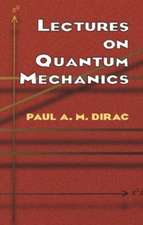The Picture Book of Quantum Mechanics
Autor Siegmund Brandt, Hans Dieter Dahmenen Limba Engleză Paperback – 19 iul 2012
- the tunnel effect
- excitation and decay of metastable states
- wave-packet motion within a well
- systems of distinguishable and indistinguishable particles
- free wave packets and scattering in 3 dimensions
- angular-momentum decomposition
- stationary bound states in various 3-dimensional potentials
- hybrid states
- Kepler motion of wave packets in the Coulomb field
- spin and magnetic resonance
Illustrations from experiments in a variety of fields, including chemistry, and molecular, atomic, nuclear, and particle physics, underline the basic as well as the practical importance of quantum mechanics. In the present, fourth edition all computer graphics are presented in full colour. It also contains additional physics topics such as hybridisation.
| Toate formatele și edițiile | Preț | Express |
|---|---|---|
| Paperback (1) | 446.25 lei 6-8 săpt. | |
| Springer – 19 iul 2012 | 446.25 lei 6-8 săpt. | |
| Hardback (1) | 447.05 lei 38-44 zile | |
| Springer – 19 iul 2012 | 447.05 lei 38-44 zile |
Preț: 446.25 lei
Nou
Puncte Express: 669
Preț estimativ în valută:
85.41€ • 88.02$ • 72.11£
85.41€ • 88.02$ • 72.11£
Carte tipărită la comandă
Livrare economică 04-18 martie
Preluare comenzi: 021 569.72.76
Specificații
ISBN-13: 9781493936953
ISBN-10: 1493936956
Pagini: 472
Ilustrații: XVI, 472 p.
Dimensiuni: 155 x 235 x 25 mm
Greutate: 1 kg
Ediția:4th ed. 2012
Editura: Springer
Colecția Springer
Locul publicării:New York, NY, United States
ISBN-10: 1493936956
Pagini: 472
Ilustrații: XVI, 472 p.
Dimensiuni: 155 x 235 x 25 mm
Greutate: 1 kg
Ediția:4th ed. 2012
Editura: Springer
Colecția Springer
Locul publicării:New York, NY, United States
Cuprins
Introduction.- Light Waves.- Probability Waves of Matter.- Solution of the Schrödinger Equation in One Dimension.- One-Dimensional Quantum Mechanics: Scattering by a Potential.- One-Dimensional Quantum Mechanics: Motion within a Potential, Stationary Bound States.- Quantile Motion in One Dimension.- Coupled Harmonic Oscillators: Distinguishable Particles.- Coupled Harmonic Oscillators: Indistinguishable Particles.- Wave Packet in Three Dimensions.- Solution of the Schrödinger Equation in Three Dimensions.- Three-Dimensional Quantum Mechanics: Scattering by a Potential.- Three-Dimensional Quantum Mechanics: Bound States.- Hybridization.- Three-Dimensional Quantum Mechanics: Resonance Scattering.- Coulomb Scattering.- Spin.- Examples from Experiment.- Simple Aspects of the Structure of Quantum Mechanics.- Two-Level System.- Analyzing Amplitude.- Wigner Distribution.- Gamma Function.- Bessel Functions and Airy Functions.- Poisson Distribution.- Index.
Recenzii
From the reviews of the fourth edition:
“This book is aimed at beginners in quantum mechanics who want to gain some insight into the various physical phenomena which happen at the (sub)atomic scale, and for which no daily experience is available. It will serve as a good complement to standard textbooks of quantum mechanics since it contains many carefully produced pictures to illustrate the fundamental concepts and ideas from quantum physics––highlighting in particular how the concepts and predictions of classical mechanics are altered and supplemented by wavelike behaviors.” (Gabriel Stoltz, Mathematical Reviews, May, 2013)
“This book is aimed at beginners in quantum mechanics who want to gain some insight into the various physical phenomena which happen at the (sub)atomic scale, and for which no daily experience is available. It will serve as a good complement to standard textbooks of quantum mechanics since it contains many carefully produced pictures to illustrate the fundamental concepts and ideas from quantum physics––highlighting in particular how the concepts and predictions of classical mechanics are altered and supplemented by wavelike behaviors.” (Gabriel Stoltz, Mathematical Reviews, May, 2013)
Notă biografică
Siegmund Brandt is Emeritus Professor of Physics at the University of Siegen, Germany.
Dr. Hans Dieter Dahmen is Professor Emeritus of Theoretical Physics at the University of Siegen, Germany.
Dr. Hans Dieter Dahmen is Professor Emeritus of Theoretical Physics at the University of Siegen, Germany.
Textul de pe ultima copertă
The aim of this book is to explain the basic concepts and phenomena of quantum mechanics by means of visualization. Computer-generated illustrations in color are used extensively throughout the text, helping to establish the relation between quantum mechanics—wave functions, interference, atomic structure, and so forth—and classical physics—point mechanics, statistical mechanics, and wave optics. Even more important, by studying the pictures in parallel with the text, readers develop an intuition for such notoriously abstract phenomena as
• the tunnel effect
• excitation and decay of metastable states
• wave-packet motion within a well
• systems of distinguishable and indistinguishable particles
• free wave packets and scattering in 3 dimensions
• angular-momentum decomposition
• stationary bound states in various 3-dimensional potentials
• hybrid states
• Kepler motion of wave packets in the Coulomb field
• spin and magnetic resonance
Illustrations from experiments in a variety of fields, including chemistry, and molecular, atomic, nuclear, and particle physics, underline the basic as well as the practical importance of quantum mechanics.
In the present, fourth edition all computer graphics are presented in full color. It also contains additional physics topics such as hybridization.
Praise for Previous Editions
"The book is highly recommended as a complement to any standard textbook in quantum mechanics, but it will also be valuable to all of us who studied quantum mechanics without the pictures." — International Journal of Quantum Chemistry
"This book would be an excellent basis for the study of special topics in a quantum physics course. Most serious students of physics and all of their teachers will want to consider having this orderly and graphic outline of introductory quantum theory at their fingertips." — American Journal of Physics
"Their aim is the presentation of the 'principal ideas of wave mechanics' in such a way that students can build a quantum intuition out of their graphics." — Scientific American
"This is a unique book. It does not provide a complete course in quantum theory, but as a companion work of reference it should be quite useful to students in providing insights into the dynamical structure of the theory." — Nature
• the tunnel effect
• excitation and decay of metastable states
• wave-packet motion within a well
• systems of distinguishable and indistinguishable particles
• free wave packets and scattering in 3 dimensions
• angular-momentum decomposition
• stationary bound states in various 3-dimensional potentials
• hybrid states
• Kepler motion of wave packets in the Coulomb field
• spin and magnetic resonance
Illustrations from experiments in a variety of fields, including chemistry, and molecular, atomic, nuclear, and particle physics, underline the basic as well as the practical importance of quantum mechanics.
In the present, fourth edition all computer graphics are presented in full color. It also contains additional physics topics such as hybridization.
Praise for Previous Editions
"The book is highly recommended as a complement to any standard textbook in quantum mechanics, but it will also be valuable to all of us who studied quantum mechanics without the pictures." — International Journal of Quantum Chemistry
"This book would be an excellent basis for the study of special topics in a quantum physics course. Most serious students of physics and all of their teachers will want to consider having this orderly and graphic outline of introductory quantum theory at their fingertips." — American Journal of Physics
"Their aim is the presentation of the 'principal ideas of wave mechanics' in such a way that students can build a quantum intuition out of their graphics." — Scientific American
"This is a unique book. It does not provide a complete course in quantum theory, but as a companion work of reference it should be quite useful to students in providing insights into the dynamical structure of the theory." — Nature
Caracteristici
Extensively uses computer graphics and pictures to visualize the subject of quantum mechanics Contains more than a hundred problems designed to help students extract the physics from the figures Complements any standard textbook on quantum mechanics, providing insights into the dynamical structure of quantum theory Presents all computer graphics in full color, and contains additional physics topics such as hybridization, bound states and scattering Includes supplementary material: sn.pub/extras















